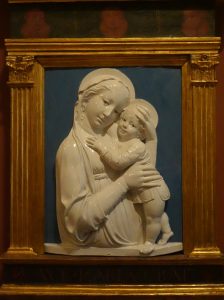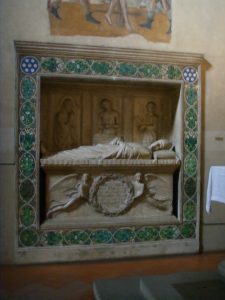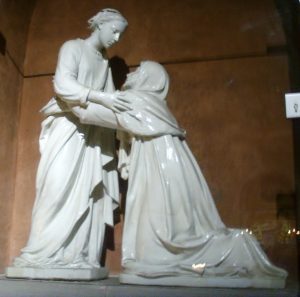Luca della Robbia was an Italian sculptor from Florence, famous for his colorful, tin glazed terracotta statue, a technique he invented and passed on to his grandson Andrea della Robbia.

Image source: https://search.creativecommons.org/photos/ff775a78-3a8a-469a-a38d-7d29c7010314 by Prof. Mortel
Although he was a prominent stone sculptor, in the early 1440s he mainly worked in terracotta after developing his technique. His workshop produced both cheaper works cast from molds in multiple versions, and more expensive one-off individually modeled.
Origins
Regarding Luca della Robbia, Vasari, Gaurico, and many other early writers give contradictory accounts. He was born in Florence, the son of a member of the Arte della Lana (guild of wool makers). According to Vasari, before working with Ghiberti at the famous doors of the Florence Baptistry, he may have trained as a goldsmith under Leonardo di Ser Giovanni. He was influenced by Donatello, and in the 1420s he worked with the architect Filippo Brunelleschi for sculpture on his buildings. Before he joined the guild of sculptor Arte dei Maestri di Pietra e Legname in 1432, his important commission for the Cantoria (“Singing Gallery”; 1431–1438) of the Florence Cathedral arrived. The Medici family, according to Vasari, was responsible for securing him the commission.

Image source: https://en.wikipedia.org/wiki/Luca_della_Robbia#/media/File:Cantoria_of_Luca_della_Robbia_2009.JPG
Early works

Image source: https://search.creativecommons.org/photos/d3d0a2f8-d073-4660-954a-3256677bdc62 by Sailko
Luca della Robbia carried out important commissions in marble and bronze including a series of marble reliefs (1437) for the bell tower of the Florence Cathedral; a tabernacle in marble and glazed terracotta (1443), now in S. Maria in Peretola; bronze angels to enrich the Singing Gallery; and also, the project of the bronze doors for the Sacristy of the Cathedral which was completed in 1469, in collaboration with Michelozzo; their dependence on a few figures placed in simple and orderly compositions on a flat background contrasts with the elaborate pictorial effects of the more famous doors of Ghiberti’s Baptistery.
The masterpiece
Probably one of the most important existing marble works by Luca (executed in 1454–1456) is the tomb of Benozzo Federighi, bishop of Fiesole, originally located in the church of San Pancrazio, in Florence, but transferred to San Francesco di Paola via Bellosguardo in 1783, only to be transferred again in 1898 to the church of Santa Trinità in Florence. An effigy of the bishop resting is placed on a carved sarcophagus with graceful reliefs of angels holding a crown that contains the inscription. Above are the three-quarter figures of Christ between St John and the Virgin, of conventional type. A rectangular frame made of painted tiles surrounds the whole. On each tile is painted, with glaze pigments, a bouquet, and fruit in bright realistic colors. Although the bouquet on each is painted on a plate, the bottom of each tile is made up of separate pieces, possibly because the soil pigment required a different degree of heat that is needed for center enamel painting.

Image source: https://search.creativecommons.org/photos/07147ac7-f7d5-4a03-94f1-f7b114c33690 by sailko
Terra-cotta works
Della Robbia’s first surviving independent sculpture is the Visitation in white tin-glazed terracotta in the church of San Giovanni Fuoricivitas of Pistoia, dating to 1445. His control of the terracotta secured him two important commissions for the Duomo of Florence: the large reliefs of the Resurrection (also from 1445) and the Ascension of Christ (1446). The flexible medium of baked clay covered with a “slide” of vitrified lead and refined minerals allowed for a shiny surface capable of reflecting light and color appropriate for architectural sculpture.

Image source: https://commons.wikimedia.org/wiki/File:Pistoia,_san_giovanni_fuorcivitas,_visitazione_di_luca_della_robbia_1445_ca._02.JPG
Working with assistants, including members of his own family, della Robbia produced a series of decorative reliefs and altarpieces to the end of his life.
Info source:
https://www.artinvest2000.com/dellarobbia_english.htm https://biography.yourdictionary.com/luca-della-robbia https://en.wikipedia.org/wiki/Luca_della_Robbia
